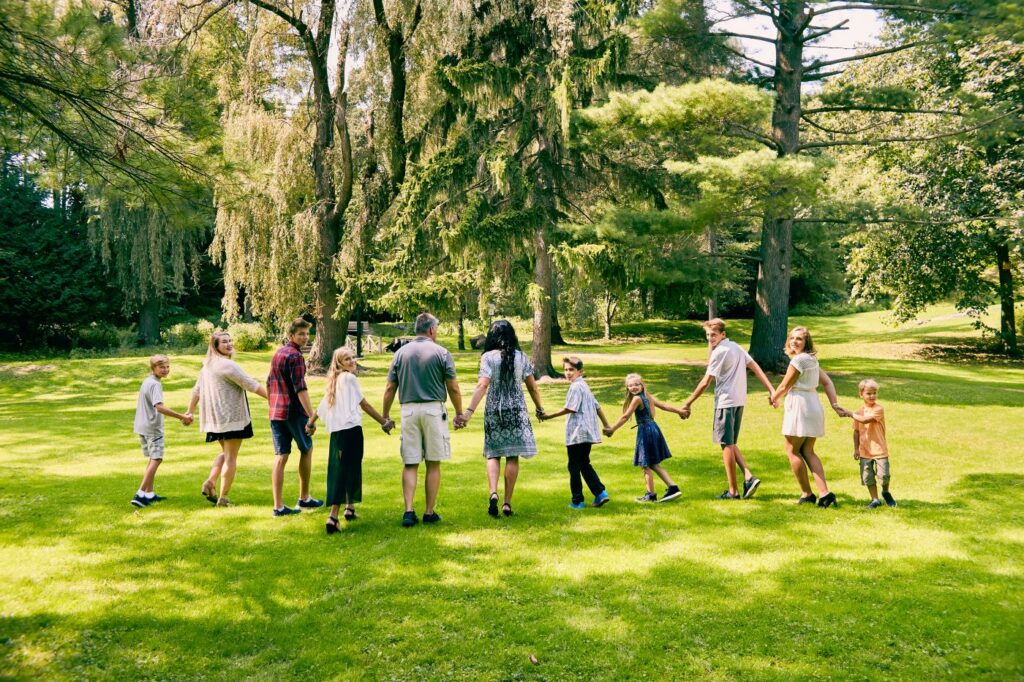Earlier this year, I (Clara) had the opportunity to interview Catherine Ruth Pakaluk about her new book, Hannah’s Children: The Women Quietly Defying the Birth Dearth, released in March 2024. Dr. Pakaluk is an Associate Professor at the Busch School of Business at the Catholic University of America. An economist and mother, she is uniquely poised to investigate the global phenomenon of falling birth rates. In 2019, she interviewed more than fifty women around the country with five or more children to find out who they are, and why they are, in her words, “strangely immune” from the fertility collapse. Her book, published by Regnery Gateway, organizes the stories of these mothers to develop a narrative revealing why they value children so much, what their children cost them, and how they think our current child scarcity affects the nation.
Clara: Perhaps the best place to start is the title—who is Hannah, and who are her children?
Catherine: First, Hannah is the fictitious name I gave to one of the mothers: a character you meet right away because her interview captured so many of the themes that I heard across the sample. This Hannah is a Jewish woman who was raised in a secular family. After college, she went on a spiritual journey that eventually took her to Israel. There, she met her husband, who was on a similar journey. When we interviewed her, she was holding her seventh child: she believed it might be her last baby but she also told us that she is “not the planner of all plans.” Her marriage, family, and whole life are entrusted to God’s Providence. So this Hannah and her seven children stand for all the women I met, because she embodies so many of the attitudes and virtues of the women in my sample.
Second, Hannah of the book title is also the biblical Hannah. I did not go into this project thinking about her, but at some point analyzing my data—we should call the narratives “data” or use the sociological term “hearing data”—various aspects of the story of the biblical Hannah jumped out at me. I saw that her basic attitudes about childbearing and the meaning of life looked like the women in my sample. The biblical Hannah became, for me, an archetype to help describe what I discovered in the stories. Though barren, Hannah prayed to be blessed with a child. We all know what came next: she received her son, Samuel. What we all don’t know these days, however, is that God sent her five more children after she brought her firstborn, Samuel, to live in the service of God. The women I met generally didn’t set about to have large families—rather, they valued children greatly, like the biblical Hannah, and saw children as blessings.
Start your day with Public Discourse
Sign up and get our daily essays sent straight to your inbox.So the title of the book refers to the character Hannah that a reader will meet at the beginning of the book, as well as to the biblical Hannah, and to the children who are in both cases the result of their faith.
Clara: In the first chapter, you write that this book is a “search of reasons, perhaps to know my own for the first time”—can you expand on this? Did your own background influence the types of questions you asked and the rapport you were able to establish with the women you interviewed?
Catherine: In the first chapter of the book, I describe a personal experience that is the true genesis of this book—the “stranger on a train” story. I won’t retell it here and spoil the fun, but the baby that I had with me in that story is almost fourteen years old now. I have been blessed with eight children in my marriage, and together my husband and I have raised six children from his first marriage. Before that, I grew up as the oldest in a family of nine. Altogether, my life has been marked by the gift of children in a profound way. As academics, I think it’s very natural for us to be interested in things that touch us personally.
Today, people are hyper-trained to see bias everywhere, and they undertake a fruitless search for neutrality in research. This is misguided. I think our research is improved by having personal experiences we bring to the table. We may have insights into questions and problems that other people may not be looking for—it doesn’t mean we have to have the last word on a topic. But yes—I was raised in a big family, I’ve had a large family, and I’ve been interested in questions of demographics and economics for a long time.
You asked about rapport. Absolutely! It’s one thing to walk into someone’s house and point out how unusual their choices have been, but it’s another thing when you can say, “I have also made these unusual choices. Let’s talk about why and what it means.” That kind of rapport was an excellent aid to interviewing a group of women who often feel misunderstood, misjudged, and marginalized.
With regard to the interview questions, I started off with a wish list of things I wanted to ask. Knowing the academic literature on family economics and demography, I knew that my project—trying to understand why some women still have many children—had great significance. But after a few pilot interviews, I learned that if you want to know why people are doing something, don’t ask them about it directly. Ask them about the years in which these choices were at hand and how they made those decisions. Pretty quickly, I scrapped my wish list and came up with a streamlined approach: I asked about when they had their first child, how they came to that decision, and what they remembered about it; then I asked them to tell me about having a second, and so on, up to the present. In that process, I heard lots of things that I don’t think I would have heard if I had started with “Why did you have ten kids?” The “why” was so often different along the way—and that was exactly what I wanted to understand. Nobody sets out to have ten—almost none of the women in my sample reported that—but some people got there. I wanted to understand that, because whatever it is that can get someone from one to more than average is the hidden immunity from low birth rates.
The other part of my interview guide contained prompts to open a conversation about self-identity, marriage quality, large families, and religious faith. Lastly, I asked them about the character of the nation, and why they thought other people didn’t make the same choices they had made. We had a variety of types of moms—stay-at-home, working full-time, working part-time, and even in our small sample one working mother with a stay-at-home dad.
Clara: Now I want to get to the heart of your project, which is to tell a story through interviews about why some women choose to have many children. You put this in economic terms—how are these women “quietly defying the birth dearth” making perfectly rational decisions?
Catherine: One of the things that has become clearer to me over time, especially since this group of women is such a hidden group, is that people misunderstand the basic motives for childbearing today. There is an implicit suggestion that religious motive is outside the relevant conversation, certainly the policy conversation, and hard to understand—something of a black box.
Why do people make the choices that they make? That’s something that economists think about a lot. We begin with the supposition that people choose to do something when it has more value to them than their perception of the costs. Such language is often caricatured and misunderstood. But a rationale of cost–benefit applies to human behavior very generally, not only in markets—especially when we see that the notions of “benefit” and “cost” are basic human phenomena of valuation and apply readily to non-economic decisions.
As I started to make sense of the data in front of me, I realized that the story was the extraordinary value they placed on children—not a story about lower costs. And I thought, that’s something worth talking about! Then the question becomes—can this inform the policy conversation? I think it can. How so? Instead of looking at larger families as an anomaly, we can pay attention to their values and where they come from: more often than not, they come from biblical faith. It’s a hopeful message. Policymakers who want to encourage births might work to make greater space for institutions that foster the type of faith that incentivizes people to have children.
Policymakers who want to encourage births might work to make greater space for institutions that foster the type of faith that incentivizes people to have children.
Clara: You shared some comments from the women in your sample about how raising children impacted their marriages. Could you elaborate on this—are babies bad for your marriage?
Catherine: Although it wasn’t the focus of my interviews, I wanted to ask about their marriages because there is a lot of stuff out there about how children can ruin a marriage—or at least the romantic part. And I heard a lot of great stories, and tried to include as many as I could. Some women really leaned into this set of questions and ended up giving me basically marriage advice, which was really charming. I kept it in the book.
Across the interviews I heard two major ideas about marriage. First was the idea that the children of a marriage can become a shared mission, something that you and your husband are partners and collaborators in undertaking. Women talked about how the shared mission of raising a large family brought them closer together as spouses, like teammates going through a championship match or something. The second thing was that the hard work of managing and responding to the admittedly large demands that come from organizing your household around three, four, five, or more children really pushes you to become better. In just the same way that we think about athletics or other great achievements that people are committed to, these women used language like “your capacity grows,” “you have more to offer,” and “you become a better version of yourself.” If you become better, and your husband becomes better, “your love grows.” For instance, one of our women referred to her husband as a hero, a rockstar, providing for her and serving her so she can take care of her babies.
It’s not a message we hear very often, and of course, while it’s true that small kids can be difficult for your marriage, it’s a phase that passes. You never hear how kids can make your marriage better.
Clara: There’s so much I’m tempted to discuss with you, but I wanted to pick up on another thread in your book that I think is really unique. The general idea comes from this quote of a mother that babies “provide their own therapy.” This came up also in the context of husbands and siblings, that is, the healing effect of the new baby on the family and even the community more broadly. Do these experiences help us understand the ongoing mental health crisis, which seems to mainly impact women and teenagers?
Catherine: Yes, I want to be a little bit modest, since this is definitely something that surprised me. It wasn’t until the third or fourth time we heard this in an interview that it seemed like something we had to mention. We interviewed fifty-five women, which is not a large sample, but it was enough of a signal that it raised an interesting future question for research.
The theme was this: in multiple instances, women talked about a time when a baby that they had welcomed into their family brought some relief from a tough spot that someone was going through, in some cases anxiety or depression. We heard this so many times in dramatic ways that it would have been irresponsible not to include it. And of course, people are really worried today about the epidemic of loneliness, highly correlated with clinical manifestations of mental suffering. The women we talked to often seemed to believe that they themselves, or their spouses, or their children, had been assisted in times of distress by babies. They said, you know, a baby just loves you and doesn’t judge you. A baby is “like a sunlamp,” one woman said.
Again, that was a really surprising and fascinating thing. I tried to be honest and just really put it out there. This is where qualitative work shines—you get these new things that maybe you didn’t ask the data before.
Clara: A natural question that arises when discussing fertility these days is, what can policy do? Your book offers quite a substantial discussion of the implications of your research for family policy—can you walk us through some of these?
Catherine: Based on my research, it looks to me that the problem of falling birth rates is not a cost problem, at least not in the way we normally think about a cost problem. The direct outlays are probably going down over time, so the real cost of children is the opportunity cost for women. When women’s opportunities expanded with education (enabled by more effective birth control), they raised the opportunity cost of having children dramatically. Of course, we’ve known this for a long time, and I’d point to the pathbreaking Goldin and Katz (2002) paper on this. So, certainly, the opportunity cost of having children has gone up, and if the benefits or values don’t change, then we would expect to see fewer children. That’s exactly what we’ve gotten. But who still has children anyway?—Those people for whom the value of having children is so incredibly large it still outweighs the high opportunity cost. These are people who, for instance, even though they went to medical school and still practice medicine, want children even more. They will work different shifts to still do their job—but they prioritize having kids.
This matters for policy. One policy response to falling birthrates might be to reduce the financial costs to parents, for instance, with cash payments to make children more affordable. But that isn’t the big margin! You can have one child, maybe two, and still hang on to your professional identity, but if you have a third or fourth, you’d really have to step away from something that you’ve been preparing for your whole life. We can’t reduce that cost unless we want to reduce women’s education, and I don’t think we want to do that. Then the question is: what gives people enough love for having children that they want to do it anyway? What I heard is that it is strong religious communities that take the biblical values seriously, and God’s grace, that tip the scale against the big challenges.
Let me be clear—I’m not against trying to make things easier for families. But most countries are so bankrupt they are mathematically committed to inflating their currencies when they spend more, which hurts families far more than small cash payments can help. I just don’t think broke modern states have any good levers left to incentivize births in ways that won’t do more harm than good.
My research made me wonder more about value formation. What is the number one way that you can affect people’s values?—Through education. Right now we’re in a rapidly evolving policy landscape on the education front, focusing especially on expanded educational savings accounts (ESAs) and forms of educational freedom generally. People think about that as a path to better educational outcomes, but not as a path to raising birth rates. But it might be a path to raising birth rates! If more people are enabled to choose educational institutions where biblical values are modeled and taught, in fifteen years, we ought to see more marriages and more babies being born. Stronger churches and more church-based schools are an “implicit” family policy.
I was expecting the hardship to be more neck and neck with the joy, but the joy was so much greater.
Clara: Finally, is there a lesson from your project that you’d like to pass on to young women currently thinking about their future careers and families?
Catherine: Yes. But I don’t want to be naive. I understand that we have real challenges in the marriage markets and labor markets right now, so giving young people advice isn’t as easy as saying, “Get married.”
I think what I would focus on from this project is what women said about their children: a lot of them spoke about how experiential it is. There is something about children, as a good to be chosen, that requires experiencing to know what it is. A lot of women in my study wish they had started earlier, since they didn’t realize how great it could be. I would definitely count myself as one of those people—I was excited to have my first child, but I didn’t know until he was born how great it would be. I thought, gosh, this has been undersold! It was hard. I was expecting the hardship to be more neck and neck with the joy, but the joy was so much greater.
I think that’s the message. I like to use the language of a train—you’re on a train as a young woman in America: grade school, high school, college, then maybe more. There isn’t much room to really come up for air—that professional train keeps chugging along but there is more to experience and try. Many people experience their first child quite late in life and, when they do, wish they had experienced it younger, because our fertility does decrease as we age.
One of the most surprising things that I heard in my interviews was that nearly all the women who were past their childbearing years would have loved to have just one more. These are women with five, six, and seven children, who told me about being really bummed out about the end of their childbearing years!
What is it about mothering that changes us so dramatically, that changes our assessment of how valuable this is over time? I think it’s surprising, worth mentioning, and I don’t know what to make of all that. It was a really neat thing to hear. In spite of all the difficulties they told me—“my body is shot,” “I’ve taken second best in my career, ” but “gosh, I would have one more.” What is this thing, that you could drag yourself through all this hardship and still want one more?
Image by Olesya Shelomova and licensed via Adobe Stock.











